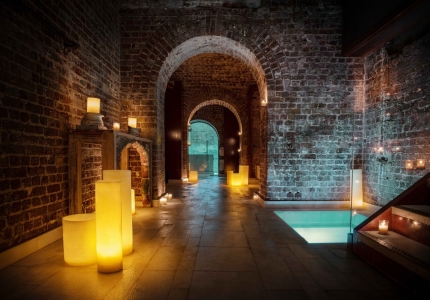Delicious, flavorful, and inspired by its regions, Spanish cuisine is as varied as any other European country. Most visitors are familiar with tapas, paella, and sangria – but they might be surprised by the fact that each city has its own set of traditional and typical dishes.
Below, we’ve highlighted some of the typical Spanish cuisine you can find in some of our favorite cities in Spain: Barcelona, Sevilla, Almeria and Vallromanes.
Barcelona:
Spanish cuisine found in Barcelona differs greatly from other regions because of two main factors: its Catalan influences and its proximity to the sea. As a coastal town, Barcelona features a lot of seafood dishes, and many meat courses are sourced from the inland Catalan region. Essentially, the Spanish cuisine of Barcelona is part of the Mediterranean diet, sourcing healthy ingredients.
One common dish in Barcelona is bacallà, or cod. Usually salted, bacallà can be shredded and served with different vegetables and sauces similar to ratatouille for a rich, filling dish. Another popular dish in Barcelona is the botifarra, or sausages. This traditional food is usually served the beans instead of potatoes, and is good sustenance after a day of hiking.
Sevilla:
As far as Spanish cuisine goes in Sevilla, the food there is very much inspired by slow-cooking techniques and its uses of spices. Located in Andalusia, which is known for its brandy and wine, Sevilla is known for its olive oil production. In addition, Seville has a lot of plans to do and enjoy the city.
One unique dish of Sevilla is rabo de toro, or bull’s tail. Slow-cooked for many hours in a sauce featuring red wine, a variety of vegetables, and stock, the result is a very flavorful and very tender meat dish. The best places to try rabo de toro would be near Sevilla’s historic bullrings. Among the multitude of pork tapas that Sevilla offers, bull’s tail definitely stands out.
After you’ve had your fill of different meat tapas and good wine, visit Ancient Aire Baths Sevilla for a nice, relaxing, detoxing soak, or a massage using local olives from Sevilla.
Almeria:
Almeria was named Spain’s Gastronomic Capital in 2019, and it’s easy to see why: the region has over 31,000 hectares of greenhouses and is considered the Pantry of Europe. Coupled with the port of Almeria and access to seafood, the Spanish cuisine here is really fresh, healthy and unique.
Consider the ajoblanco, a cold almond and garlic soup that’s perfect for summer days, or migas, a semolina dish featuring peppers and chorizo. The ingredients for both are simple yet delicious. While ajoblanco may sound like an odd dish, the flavors balance each other really well.
Another simple, yet tasty Spanish cuisine dish of Almeria is squid. Simply called squid in olive oil, this tender dish features squid slow-cooked in olive oil, white wine, and garlic for a lovely Mediterranean taste.
Vallromanes:
We’ve covered meat and fish, which makes up a large portion of Spanish cuisine, but what about vegetables?
Like Barcelona, the village of Vallromanes shares Catalon influences on its cuisine. But Vallromanes dishes emphasize more local ingredients in their dishes, so you might find a more farm-friendly or organic approach to a dish. Baccala, for example, would be served with potatoes and roasted peppers. Mushrooms, spinach, eggplants and potatoes pop up frequently in many of the traditional Spanish cuisine served in Vallromanes, because those are the types of produce grown locally.
The village’s Spanish cuisine is vegetarian/pescatarian friendly as well, with rice, risotto dishes and paella dishes. Even Catalan desserts made with passionfruit, panna cotta, or chocolate will have a local flavor added.The Spanish cuisine of these four different cities vary greatly, but they all share healthy, delicious, local ingredients in common.
Cooking techniques and use of spices really shine through in differentiating the different types of dishes to be found in Spain, in part because of the country’s various influences in flavor, from Italian to Arabic.
Much like the blend of influences in Spanish cuisine, AIRE Ancient Baths has a blend of ancient influences in its baths designs and spa offerings. So after immersing yourself in a day of Spanish food and flavors, immerse yourself in the relaxing thermal baths that have a range of Mediterranean influences.



